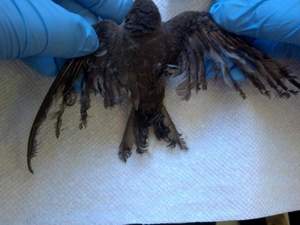Power Plants Frying Feathers
Solar is good, but needs some redesign to protect the birds.
USA Today ran an excellent article on solar projects in California written by K Kaufmann of The Desert Sun. K Kaufmann has many other interesting articles on the greenenergy blog of The Desert Sun that you can read HERE.
(Just a reminder that former Director of the Bureau of Land Management, Bob Abbey, is a partner of Abbey, Stubbs & Ford, which has BrightSource Energy as a client.) – Debbie Coffey
SOURCE: USA TODAY
by K Kaufmann, The Desert Sun
At the moment, Ivanpah — now in the testing stage — is the largest solar thermal plant in the world.
A small bird, barely the size of a human hand, had its wings reduced to a web of charred spines. No longer able to keep aloft, the bird was found on the ground after it had flown through the intense heat of a solar thermal project soon to go online in the California desert.
2010: Major Calif. solar projects make progress
The photograph, taken at BrightSource Energy’s Ivanpah plant in east San Bernardino County, has raised the stakes for a similar project in Riverside County. Months from final state and federal approvals, the Palen solar thermal power system could put two 750-foot-tall solar towers and thousands of reflecting mirrors near two of the region’s key wildlife refuges and stopping points for birds migrating along the Pacific Flyway.
The project is roughly 50 miles from both the Salton Sea to the southwest and the Cibola National Wildlife Refuge in Arizona to the southeast.
“A migrating bird has to be in top form, having the flight feathers in really good shape,” said ornithology collections manager Kimball L. Garrett of the Museum of Natural History of Los Angeles County, who has not seen the picture from Ivanpah but has been concerned about bird deaths at large solar projects.
“If some of its flight feathers are damaged, what does that mean for the rest of the bird’s migration?” he said. “It weakens feathers. These are things people don’t study because — how can you?”
Trying to estimate how many birds could be injured or killed because of large-scale solar projects and what might be done to prevent deaths has become a pressing concern for solar developers and environmental agencies as these projects multiply. Developers hope to have the Palen project online in 2016.
Of 34 birds reported dead or injured at Ivanpah in September, 15 had melted feathers. Dozens of other bird carcasses, not singed but with critical injuries, have been found in recent months at two solar projects about to go online on public land between Joshua Tree National Park and Blythe, Calif., a town of 20,800 on Interstate 10 near the Arizona border.
READ THE REST OF THIS ARTICLE AND SEE THE VIDEO HERE: http://www.usatoday.com/story/news/nation/2013/11/10/bird-feathers-singed-solar-power/3491617/


